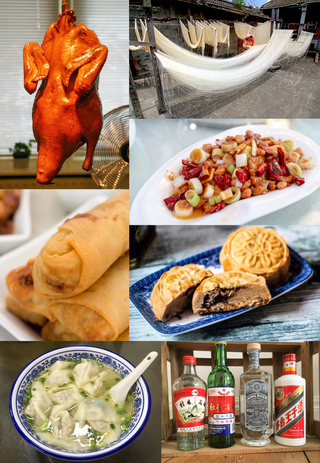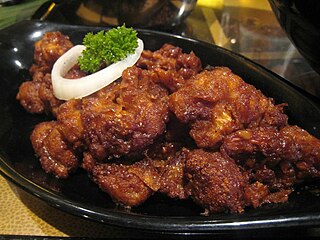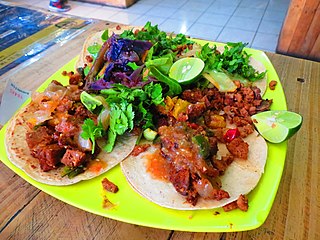
Chinese cuisine comprises cuisines originating from China, as well as from Chinese people from other parts of the world. Because of the Chinese diaspora and historical power of the country, Chinese cuisine has profoundly influenced many other cuisines in Asia and beyond, with modifications made to cater to local palates. Chinese food staples such as rice, soy sauce, noodles, tea, chili oil, and tofu, and utensils such as chopsticks and the wok, can now be found worldwide.

A cuisine is a style of cooking characterized by distinctive ingredients, techniques and dishes, and usually associated with a specific culture or geographic region. Regional food preparation techniques, customs, and ingredients combine to enable dishes unique to a region.

Fusion cuisine is a cuisine that combines elements of different culinary traditions that originate from different countries, regions, or cultures. Cuisines of this type are not categorized according to any one particular cuisine style and have played a part in many contemporary restaurant cuisines since the 1970s.

Korean cuisine has evolved through centuries of social and political change. Originating from ancient agricultural and nomadic traditions in Korea and southern Manchuria, Korean cuisine reflects a complex interaction of the natural environment and different cultural trends.

Mexican cuisine consists of the cooking cuisines and traditions of the modern country of Mexico. Its earliest roots lie in Mesoamerican cuisine. Its ingredients and methods begin with the first agricultural communities such as the Olmec and Maya who domesticated maize, created the standard process of nixtamalization, and established their foodways. Successive waves of other Mesoamerican groups brought with them their cooking methods. These included: the Teotihuacanos, Toltec, Huastec, Zapotec, Mixtec, Otomi, Purépecha, Totonac, Mazatec, Mazahua, and Nahua. With the Mexica formation of the multi-ethnic Triple Alliance, culinary foodways became infused.

Soul food is the ethnic cuisine of African-Americans. It originated in the American South from the cuisines of enslaved Africans trafficked to the North American colonies through the Atlantic slave trade during the Antebellum period and is closely associated with the cuisine of the American South. The expression "soul food" originated in the mid-1960s, when "soul" was a common word used to describe African-American culture. Soul food uses cooking techniques and ingredients from West African, Central African, Western European, and Indigenous cuisine of the Americas. Soul food came from the blending of what African Americans ate in their native countries in Africa and what was available to them as slaves. The cuisine had its share of negativity initially. Soul food was initially seen as low class food, and Northern African Americans looked down on their Black Southern counterparts who preferred soul food. The term evolved from being the diet of a slave in the South to being a primary pride in the African American community in the North such as New York City.
Taiwanese cuisine is a popular style of food with several variations, including Chinese and that of Taiwanese Indigenous peoples, with the earliest cuisines known of being the indigenous ones. With over a hundred years of historical development, mainstream Taiwanese cuisine has been influenced by Hakka cuisine, the cuisines of the waishengren, Japanese cuisine, and American cuisine, with southern Fujian cuisine having had the most profound impact.

Asian food incorporates a few significant provincial cooking styles: Central Asian, East Asian, North Asian, South Asian, Southeast Asian, and West Asian. A food is a trademark way of cooking practices and customs, usually associated with a specific culture. Asia, being the largest and most populous continent, is home to many cultures, many of which have their own characteristic cuisine. Asian cuisine are also famous about their spices.

Indonesian cuisine is a collection of various regional culinary traditions that formed in the archipelagic nation of Indonesia. There are a wide variety of recipes and cuisines in part because Indonesia is composed of approximately 6,000 populated islands of the total 17,508 in the world's largest archipelago, with more than 1,300 ethnic groups.

Latin American cuisine is the typical foods, beverages, and cooking styles common to many of the countries and cultures in Latin America. Latin America is a highly racially, ethnically, and geographically diverse with varying cuisines. Some items typical of Latin American cuisine include maize-based dishes arepas, empanadas, pupusas, tacos, tamales, tortillas and various salsas and other condiments. Sofrito, a culinary term that originally referred to a specific combination of sautéed or braised aromatics, exists in Latin American cuisine. It refers to a sauce of tomatoes, roasted bell peppers, garlic, onions and herbs. Rice, corn, pasta, bread, plantain, potato, yucca, and beans are also staples in Latin American cuisine.

Indian Chinese cuisine, Chinese Indian cuisine, Sino-Indian cuisine, Chindian cuisine, Hakka Chinese or Desi-Chinese cuisine is a distinct style of Chinese cuisine adapted to Indian tastes, combining Chinese foods with Indian flavours and spices. Though Asian cuisines have mixed throughout history throughout Asia, the most popular origin story of the fusion food resides with Chinese labourers of Calcutta, who immigrated to British Raj India looking for work. Opening restaurant businesses in the area, these early Chinese food sellers adapted their culinary styles to suit Indian tastes.
The global cuisine or world cuisine is a cuisine that is practiced around the world. A cuisine is a characteristic style of cooking practices and traditions, often associated with a specific region, country or culture. To become a global cuisine, a local, regional or national cuisine must spread around the world, its food served worldwide. There have been significant improvements and advances during the XX century in food preservation, storage, shipping and production, and today many countries, cities and regions have access to their traditional cuisines and many other global cuisines.

Street food in South Korea has traditionally been seen as a part of popular culture in Korea. Historically, street food mainly included foods such as eomuk, bungeo-ppang and tteok-bokki. Street food has been sold through many types of retail outlets, with new ones being developed over time.

North Korean cuisine is the traditional culinary practices and dishes of North Korea. It's foundations are laid by the agricultural and nomadic traditions in southern Manchuria and the Korean Peninsula. Some dishes are shared by the two Koreas; however, availability and quality of Northern cuisine is much more significantly affected by sociopolitical class divides.

Mexican-American cuisine is the cuisine of Mexican Americans and their descendants, who have modified Mexican cuisine under the influence of American culture and immigration patterns of Mexicans to the United States.














